Early Verdict
The CR280 is an excellent choice for anyone looking for a nice compact case with good features for a low price. Though some of Riotoro’s design decisions along with only average performance prevent us from outright recommending the CR280, it still gains our seal-of-approval for anyone looking for a good, cheap case.
Pros
- +
Low price
- +
Efficient use of space
- +
Good cooling from preinstalled fans
Cons
- -
Average overall performance
- -
Mix of snap off / reusable slot covers
- -
Paper accent ring / logo highlight
Why you can trust Tom's Hardware
Features & Specifications
After reviewing a series of higher-priced, premium Mini-ITX cases, we decided to give our readers a break and return to some of the more budget-oriented (or at least cheaper) models that are sitting in our queue. Today’s sample, the Riotoro CR280, comes from a company known for its low cost cases.
In addition, we‘re also moving away from the oversized Mini-ITX cases we’ve reviewed recently in favor of cases that are small enough to legitimately be called a “compact” case. At just under 13” tall, Riotoro has managed to take a Mini-ITX tower about as small as it can go before you have to either start removing features or at least get very creative about the placement of items within the case.
Specifications
The Riotoro CR280 is built as you would expect for a budget model case, with a painted steel and plastic construction, and a small polycarbonate window for showing off your build. Unlike some budget model cases, the CR280 uses somewhat thicker steel, which in turn gives the case a somewhat higher quality look and feel. However, this is still a $55 case, and as we’ll see in a bit there are still some design aspects that remind you about that price.
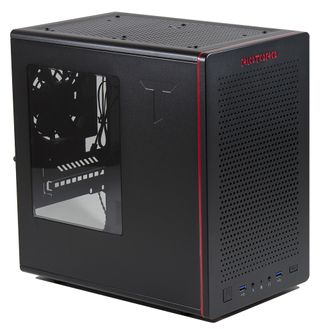
The CR280 is designed with airflow in mind, featuring well-ventilated front and top panels, and plenty of room throughout the case for mounting fans. While the overall design is a bit minimalist, Riotoro did throw in a red accent ring and highlighted logo to try to break things up a bit. The company also stamped a large “T” on both of the case’s side panels in a further attempt to add a bit of variety.
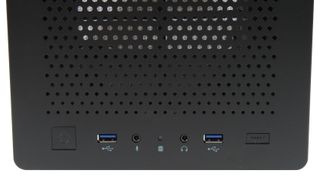
Returning to the front panel, at the bottom we find the standard set of front I/O ports, which include a pair of USB 3.0 ports, a pair of audio ports, and the power and reset buttons. The hard drive activity light is easy to spot with its front-and-center position. However, the power light is a different story. Though you might be inclined to think it’s hidden away in the power button, it’s actually mounted underneath the case and provides a red underglow at the front of the case when your computer is on.
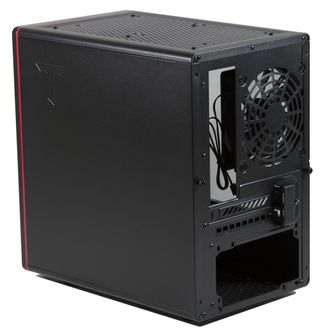
Moving on to the rear of the case, the CR280 comes with a 120mm fan mounted in the rear mount. There’s also the standard motherboard cutout, and below that, a pair of expansion slots complete with shroud and a cutout for a PS/2 form-factor power supply.
At this point, our detail-oriented readers may also notice that each of the expansion slot covers appear to be different. Riotoro saw fit to give the CR280 one replaceable and one snap-off expansion slot cover. While it’s probably not a deal breaker for anyone interested in this case, it still seems like a cheap move considering how inexpensive slot covers are and serves to remind you that this is still a $55 case.
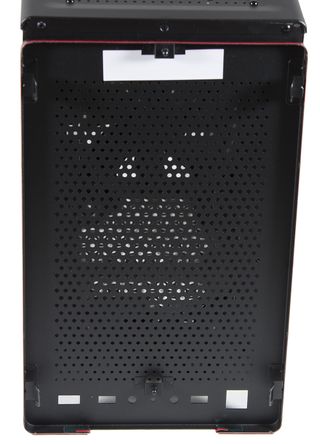
Each side panel is secured by a single thumbscrew, while the front panel is secured by push-in latches. Upon removing the front panel, we noticed that something was amiss with that red accent at the front of the case. In what appears to be another effort to reduce CR280 production costs, it seems the accent ring is simply a strip of laminated paper wrapped around the panel and taped to the bottom. Additionally, the red logo appears to have received the same treatment.
As with the expansion slot covers, this probably isn’t a deal breaker, and we know Riotoro has to do something to keep the costs down. It would still be nice to see a little more creativity thrown in.
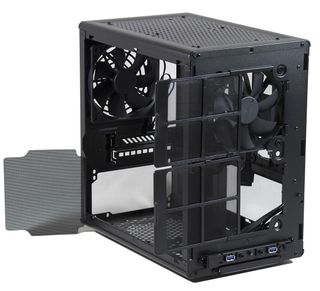
Riotoro does try to make up for some of these cut corners with extra effort on other features. Once we removed the front and side panels, we found that the CR280 came with a nice complement of air filters. Two slide-out filters up front provide filtration for the factory-installed 120mm fan plus a second 120mm fan if you decide you need more cooling. Similarly, there’s also a removable power supply dust filter located under the rear of the case.

Further inspection reveals another air filter that is secured to the top of the case using removable plastic rivets. Underneath this filter is a mount for two 120mm fans, and while there isn’t enough space above the motherboard to mount a radiator here, Riotoro did give the mounts a healthy lateral offset that should keep the fans clear of anything that sticks up on the motherboard.

Because the CR280 is so small, there really isn’t much to talk about inside the main build area of the case. The motherboard tray comes with vibration-dampening mounts for two SSDs or 2.5” hard drives, and a single vibration-dampening mount for a 3.5” hard drive. There are a handful of cutouts for passing cables through to the other side as well as a number of tie-down points for securing cables. Finally, there’s about 1/2" (12mm) of room between the side panel and motherboard tray, which provides a bit of clearance for hiding cables.
MORE: Best Cases
MORE: All Case Content
-
itsmedatguy great price, but I wish some more case manufacturers would build some higher end ITX cases that are actually this compact. Lian Li seems like the best bet, but I'm not interested in spending 2-300 on a caseReply -
DarkSable I mean, this is great value, and it's a good starting point for getting into small form factor builds. You're also right that going much smaller is going to require a more optimized layout, though that's really not a drawback aside from perhaps being slightly trickier to build in the first time.Reply
However, do bear in mind that when talking about SFF as an enthusiast niche, this case really isn't that small - 320mm x 203mm x 330mm works out to 21.5 liters. The widely available Silverstone Raven is just 14 liters, and there are specialty cases which use completely off-the-shelf parts to build gaming computers in a half to a third of this case. Heck, the S4 mini comes with a custom power supply, can fit up to an itx gtx 1080, and is less than a quarter of the volume of this case.
I mean, there are people designing cases to fit full ATX computers into ~23 liters.
I've said things like this before and gotten lukewarm responses, so let me just qualify this: Yes, those are pricy solutions, and yes, it's very niche... But someone interested in a case like this, who hasn't yet found the world of SFF computing, deserves to know about it. Surely it can't hurt to add two sentences to your article saying, "I know this case is tiny compared to a regular ITX chassis, but coming at it from the other perspective, 21.5 liters makes this a somewhat sizeable case for those niche enthusiasts who are into SFF computing."
(That's another thing I'd love to see; the dimensions are a start, but giving the volume in the stats would be super nice when talking about ITX cases. It's an easy calculation, and google will do it for you if you just type in the dimensions in mm multiplied by each other.) -
shrapnel_indie Reply20009227 said:(That's another thing I'd love to see; the dimensions are a start, but giving the volume in the stats would be super nice when talking about ITX cases. It's an easy calculation, and google will do it for you if you just type in the dimensions in mm multiplied by each other.)
For that to be most effective, one has to use internal measurements and not external, which is a little harder to find. -
shrapnel_indie One positive about the "paper wrap" for a color filter on the LEDs. If you don't want red, you can change it easy enough. the red strip around the front of the case is a different matter, but if you can live with that and different colors for the LEDs...Reply -
jmcgaw I'm guessing that this thing must take some sort of drives. Or does it? Additionally, a case of this configuration might attract someone who wants a small HTPC and for that most builders would like to have an optical drive up front. Was any of this addressed in the review? I didn't see it but maybe old age is taking its toll...Reply

